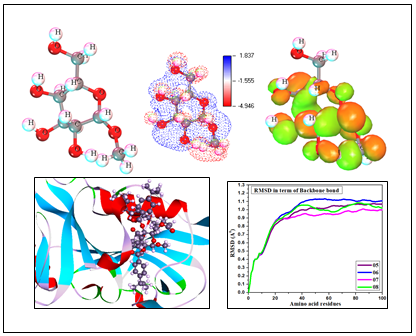JOURNAL 2397
Organic Communications
Year: 2022 Issue: 2 April-June
p.184 - 203
Viewed 2933 times.
GRAPHICAL ABSTRACT

ABSTRACT
The methyl α-D-glucopyranoside and its derivatives have been estimated as the antimicrobial agents against numerous human pathogens, which is constantly amplifying the attention of medicinal chemists to design new bioactive molecules and their structure-activity relationship (SAR) while the computational tools are the most lucid and trustable avenue to perform their theoretical profile building up. Firstly, the predictionof activity spectra for substances (PASS) value has illustrated initially information about the antifungal, antibacterial, antiviral, and anticancer potential. It was observed that the PASS predicted pathogens supported their score higher in fungal species than bacteria. However, the “Lipinski five rule” has been monitored for drug-likeness properties. After confirming their biological significance, molecular docking has been completed against both the bacteria and fungi and these docked complexes have been optimized for molecular dynamics through the water system. A molecular docking study against nine bacterial and fungal pathogens revealed promising binding affinity and non-bonding interaction mostly for derivatives (5-8). The chemical descriptors have been obtained using the density functional theory (DFT) and predict their chemical stability and softness in the biological system. The molecular dynamics study was found to be the best stability of all docked complexes. At last, the ADMET properties have been calculated and provide the safe use and non-carcinogenic fact with low toxicity for both aquatic and non-aquatic species. Finally, it is concluded that these selected derivatives (5-8) are highly antifungal potential molecules than antibacterial potential which has been varied with respect to their structural side chain in the D-glucopyranoside sequence.
KEYWORDS- Chemical stability
- pass prediction
- molecular dynamics
- DFT calculation
- ADMET